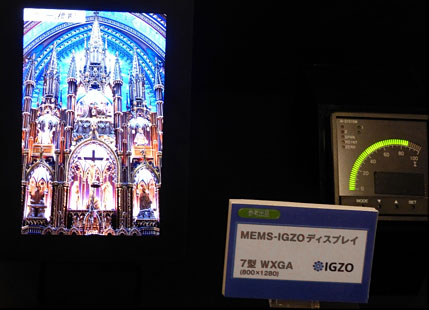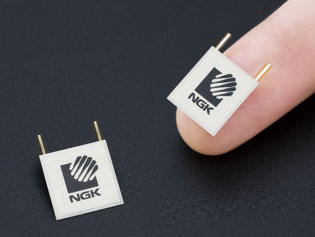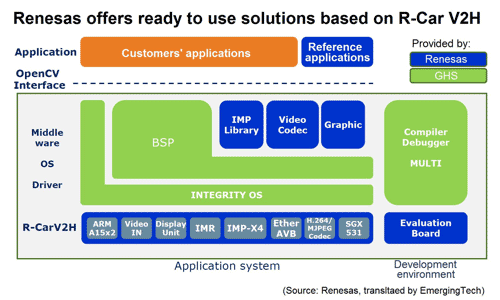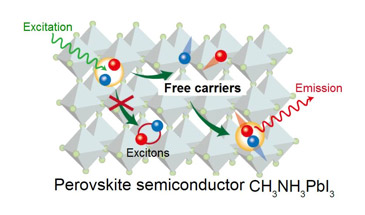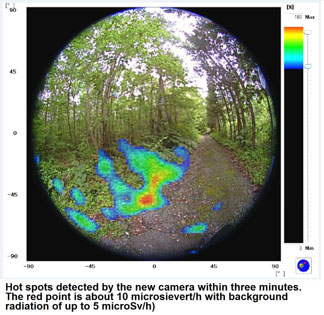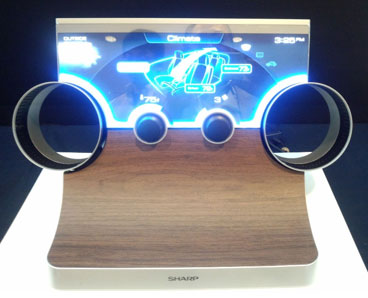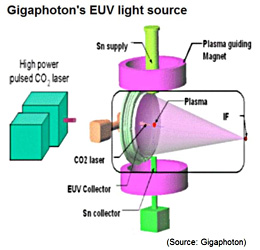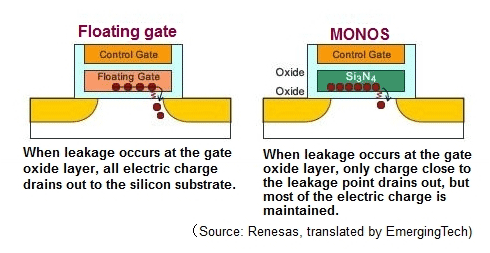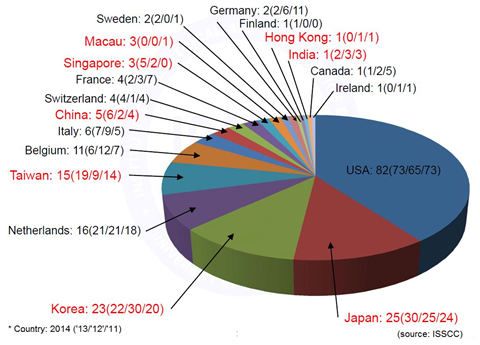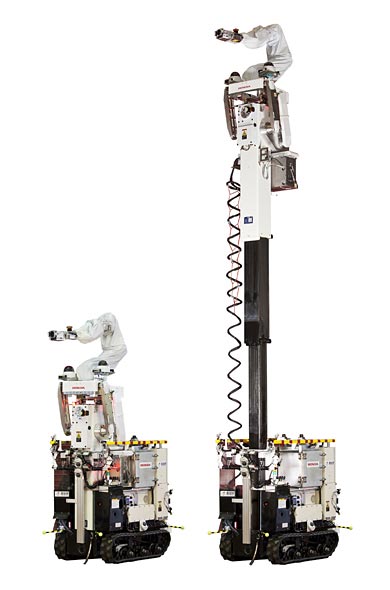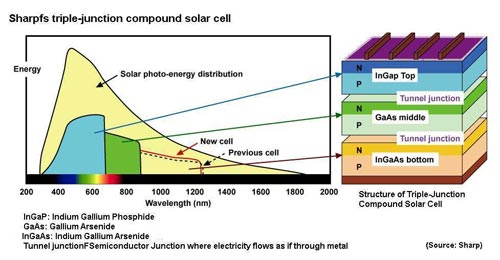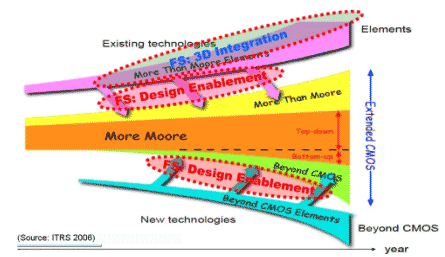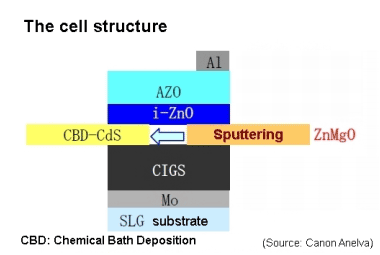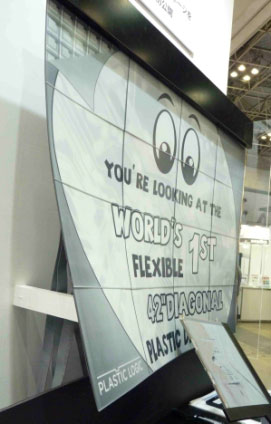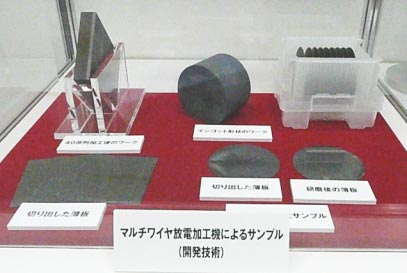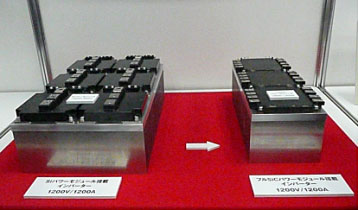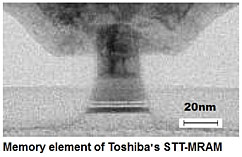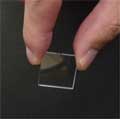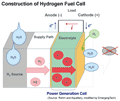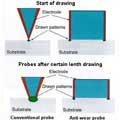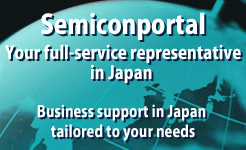Technology
Sharp Corp. has demonstrated a MEMS display jointly developed with Qualcomm subsidiary Pixtronix Inc. and announced it will be commercialized in 2017. The Japanese company will deploy this new display—dubbed the MEMS-IGZO display because it is a fusion of MEMS and IGZO technologies—in a bid to expand the use of displays to applications beyond the reach of LCDs.
[... more]
NGK Insulator Ltd. has developed a solid-state ceramic lithium-ion battery whose density is roughly 10 times that of conventional solid-state batteries, and moreover, it is capable of working at high temperature of about 120 degrees centigrade, enabling it to be closely apposed with chips on a circuit board.
[... more]
Renesas Electronics Corp. has announced the R-Car V2H system-on-chip LSI, its first product dedicated for advanced driver assistance system (ADAS) applications. Sampling begins this month.
[... more]
A team at the Institute for Chemical Research of Kyoto University has clarified the behavior of electrons and holes in organometal halide perovskite semiconductor (CH3NH3PbI3), which is a focus of growing interest as one of the most promising next-generation solar cells.
[... more]
Waseda University and Hamamatsu Photonics K.K. have developed a handy Compton camera whose high sensitivity enables it to locate gamma radiation within a few seconds.
[... more]
Displays have always been squeezed into a rectangular straitjacket. Even if a display has rounded corners or is curved, the basic form is rectangular. Now, here comes Sharp Corp. with its revolutionary Free-Form Display to set displays free. The FFD allows great freedom in the design of display shape. Sharp developed the panel by implementing gate drivers within pixel areas, not at the edges as in conventional panels. Sharp calls it in-pixel gate driver monolithic (IPGDM) technology.
[... more]
Gigaphoton Inc., a wholly owned subsidiary of Komatsu Ltd., has developed a prototype laser-produced plasma (LPP) light source unit that achieved 92W extreme ultraviolet (EUV) light source output at 4.2% conversion efficiency—more than doubling the company's previous result of 43W.
[... more]
Renesas Electronics Corp. announced it has developed a 28nm embedded flash memory intellectual property based on its proprietary MONOS flash structure and that the IP satisfies requirements such as data retention time, cycle time and speed for embedded flash memory of microcontrollers for automotive applications.
[... more]
The skyrocketing amounts of data involved in semiconductor manufacturing processes make analysis methodologies similar to those required for big data analysis essential. This was the context for discussion at AEC/APC Symposium Asia 2013, held in Tokyo last November, on measures to cope with the rising tide of data associated with semiconductor manufacturing processes.
[... more]
The International Solid-State Circuits Conference (ISSCC) 2014 will be held in San Francisco from February 9 to 13 under the overarching theme of "Silicon Systems Bridging the Cloud." 206 papers have been accepted, a tad fewer than the 209 for ISSCC 2013. The United States is ranked top with 82 accepted papers, followed by second-ranked Japan with 25.
[... more]
Honda Motor Co., Ltd. and the National Institute of Advanced Industrial Science and Technology (AIST) have jointly developed a remotely controlled survey robot, which Tokyo Electric Power Company, Inc. (TEPCO) started using at Fukushima Daiichi Nuclear Power Plant on Tuesday (June 18).
[... more]
At the 16th annual IEEE International Interconnect Technology Conference (IITC) 2013, to be held at Kyoto Research Park in Kyoto from June 13 to June 15, interconnect technology destined to play a critical role in future microelectronics will be discussed at a gathering of over 200 of the world's leading researchers and engineers. The conference, sponsored by IEEE Electron Devices Society and technically co-sponsored by The Japan Society of Applied Physics, is the second IITC conference in Japan, following an interval of 4 years.
[... more]
Sharp Corp. announced on Wednesday that its triple-junction compound solar cell has achieved 37.9% conversion efficiency, which is the highest ever reported, the company said.
[... more]
The 2013 Symposia on VLSI Technology and Circuits will present the big picture, with coverage ranging from More Moore technologies heading beyond 22nm and up-and-coming More than Moore technologies, including 3D integration, to tunnel FET and other emerging Beyond CMOS technologies. The number of papers on Beyond CMOS themes is rising, indicating that the industry is changing gears as a new technology trend offers greater possibilities.
[... more]
Toppan Printing Co., Ltd. and Cambridge UK-based Plastic Logic Ltd. have jointly developed a 42-inch flexible, reflective plastic display panel for signage and demonstrated it at Retail Tech Japan 2013 in Tokyo, which is being held this week.
[... more]
Toppan Printing Co., Ltd. and Cambridge UK-based Plastic Logic Ltd. have jointly developed a 42-inch flexible, reflective plastic display panel for signage and demonstrated it at Retail Tech Japan 2013 in Tokyo, which is being held this week.
[... more]
Mitsubishi Electric Corp. has developed multi-wire electrical discharge processing technology to slice a 4-inch square polycrystalline silicon carbide (SiC) ingot into 40 wafers in one go, which improves yield about 30%. Having demonstrated the technology at its annual R&D open house in mid-February, Mitsubishi aims to commercialize the slicing system in 2015.
[... more]
Mitsubishi Electric Corp. announced at its annual R&D open house the development of a full-SiC module consisting of SiC Schottky barrier diodes (SBDs) and SiC metal-oxide-semiconductor field-effect transistors (MOSFETs), which can handle 1,200A current under 1,200V, the largest capacity so far reported. Mitsubishi aims to commercialize the module within two years.
[... more]
Toshiba Corp. announced it has developed a spin-transfer torque magnetoresistive random access memory (STT-MRAM) that has overcome the MRAM's trade-off between power consumption and speed to achieve a performance superior to SRAM's in terms of speed and power consumption. Simulation showed an ARM processor with the MRAM cache consumes about 1/3 of the power required for a conventional SRAM configuration. Toshiba researchers believe they are blazing a trail toward the eventual replacement of SRAM by a non-volatile memory.
[... more]
Nichia Corp. has developed a high-power 525nm green laser diode whose optical output power exceeds 1W, about 10 times higher than that of other green lasers announced so far. The high-power solid green laser is expected to fulfill the chip set of three primary colors—red, green and blue.
[... more]
In a world already awash with digital data, we are producing the stuff at an ever increasing rate, but our ability to preserve this digital inheritance is another story. None of the current media makes the cut when it comes to storage for hundreds of years. Now, using fused silica glass as the storage media, researchers at the Central Research Laboratory of Hitachi, Ltd. may have a solution capable of storing data without significant deterioration for hundreds of millions of years.
[... more]
Fuel cells that may solve all the drawbacks of current batteries have been developed jointly by Rohm Co. Ltd., Aquafairy Corp. and Kyoto University. The solid hydrogen fuel cell, which employs a disposable hydrogen-generating sheet made of a calcium compound that is the size of a strip of chewing gum, directly supplies hydrogen to the generator, thus eliminating the need for a hydrogen storage container, and generates 5Wh—enough for one-time charging of a power-hungry smartphone or other mobile device. Rohm and Aquafairy are aiming for commercialization next year.
[... more]
Toshiba Corp., in collaboration with Tokyo University and BEANS Laboratory, has greatly improved durability of the probe that is an essential component in probe anode oxidation lithography technology, one of the candidate next-generation lithography solutions, to a level enabling all patterns in a one-shot area to be drawn, the minimum requirement for mass-production equipment. The research team presented the technology at IEEE/APCOT2012, which is being held in Nanjing, China, this week.
[... more]
Sumitomo Electric Industries, Ltd. and Sony Corp. have jointly developed a 532nm green semiconductor laser with 100mW output power. Filling the vacancy in the set of three primary colors—red, green and blue, this high-power green semiconductor laser should make it possible to address various needs ranging from those in the biomedical and other specialized field to business and consumer applications such compact projectors and ultra-compact projectors embedded in portable devices. The timing of commercialization has yet to be disclosed.
[... more]
Semiconductor Energy Laboratory Co., Ltd. (SEL), an R&D specialty company that with Sharp Corp. jointly developed IGZO TFT displays driven by crystalline oxide semiconductor based on indium, gallium and zinc (hence IGZO), is championing the crystalline IGZO technology for LSIs too. As well as presenting a paper on a normally-off CPU at SID2012, a display industry get-together in Boston, SEL also revealed to EmergingTech the game-changing possibilities crystalline IGZO technology may bring to LSIs-ultralow-power-consumption CPUs, non-volatile memories, high-speed image sensors and more.
[... more]
"Consumers are strongly demanding high resolution and low power consumption for mobile devices," said Shigemitstu Mizushima, Sharp's executive vice president and chief technology officer, in his keynote speech at FineTech Japan earlier this month. Sharp expects the resolution will soon advance from the current 300 ppi for smartphones to 500 ppi and that even the larger panels for tablets will feature over 400 ppi soon, according to Mizushima.
[... more]
Hitachi, Ltd. has demonstrated a small humanoid robot, Emiew2, endowed with network-linked image recognition employing a database of over 100 million images gathered from the Internet.
[... more]
A 3D tsunami simulation project will run on the K computer, which achieved a performance exceeding 10 petaflops and took the No. 1 position for the second time running in the Top500 List of the world’s most powerful supercomputers.
[... more]
The New Energy and Industrial Technology Development Organization, Japan's largest R&D management organization under the jurisdiction of the Ministry of Economy, Trade and Industry (METI), is now devoting a third of its annual budget of about 150 billion yen (US$1.9 billion*) to projects executed outside Japan.
[... more]
Riken and Fujitsu have taken the No. 1 position with the "K computer" in the 38th TOP500 list announced on November 14 in the United States, retaining the top position achieved in the previous 37th TOP500 list announced in June.
[... more]
Riken and Fujitsu Ltd. have jointly announced that the K computer surpassed the initial performance target of 10 petaflops (quadrillion floating-point operations per second) in October with its final configuration of 864 computer racks or 88,128 CPUs, attaining a computing efficiency ratio of 93.2%. Last June, the K computer's performance of 8.162 petaflops with about 80% of the final configuration was ranked No. 1 in the 37th TOP500 list. Capitalizing on its position at the head of the TOP500 list, Fujitsu has started aggressively marketing supercomputer systems based on technology developed for the K computer.
[... more]
"Our ultimate goal is to develop transparent resin that conducts electricity. Such resin may be able to replace ITO, which uses rare materials and is expensive," said Hiroyuki Muto, associate professor of the Department of Electrical and Electronic Information Engineering, Toyohashi University of Technology, whose team developed a production method that allocates carbon nanotubes efficiently at particle boundaries to make the material electrically conductive.
[... more]
A team at the R&D Partnership for Future Power Electronics Technology (FUPET) has developed an all-SiC-device-based three-phase inverter with a 0.5-liter volume, which was verified to achieve an output power density of 30kWh/l. "We believe this is the world's highest output power density for a small-volume inverter," said Satoshi Tanimoto, chief researcher at FUPET's R&D Center.
[... more]
The New Energy and Industrial Technology Development Organization (NEDO) has posted service robot software modules (robotic technology components) on the OpenRTM-aist site. The modules are some of the fruits of NEDO's five-year Next Generation Robot Software Development Project, scheduled for completion next March.
[... more]
The EUVL Infrastructure Development Center, Inc. (EIDEC), an EUV lithography R&D company, established by 11 of Japan's semiconductor-related companies last January, held a kick-off symposium on June 17 and has started operation with Intel, Samsung Electronics, TSMC and Hynix Semiconductor participating as development partners.
[... more]
Japan's K Computer, being developed by Riken and Fujitsu Ltd., took first place with its halfway configuration on the 37th TOP500 list announced on Monday at the 26th International Supercomputing Conference (ISC'11) in Hamburg, Germany. "Without collaboration with several companies in earthquake-stricken Tohoku that did their utmost to recover, we could not have attained the top position," stressed Michiyoshi Mazuka, chairman and representative director of Fujitsu.
[... more]
Japan and the EU have launched a joint R&D project, with about 11.5 million euros in funding, to develop concentrator PV cell and module technology targeting the world's highest conversion efficiency of 45% for cells and 35% for modules.
[... more]
Employing a bottom-up method, a Kyoto University research team together with Japan Synchrotron Radiation Research Institute (JASRI) has fabricated carbon nanotubes in a flask at room temperature. The nanotubes exhibit semiconductor characteristics and can selectively absorb specific gas molecules.
[... more]
NTT Docomo, Inc. is preparing for field tests with LTE-Advanced, the fourth generation mobile communications technology, which will start immediately once the Ministry of Internal Affairs and Communications issues the license to the company, probably in March.
[... more]
A research group of Japan Advanced Institute of Science and Technology (JAIST) has succeeded in developing amorphous-silicon solar cell by coating liquid silicon ink.
[... more]
Toshiba Corp., together with Tokyo University and BEANS Laboratory, has developed a durable probe, an essential component of probe anode oxidation lithography technology, one of the candidate next-generation lithography solutions, and reported that the prototype probe showed about 25-times-higher durability than currently available probes at the IEEE/MEMS2011 held in Cancun, Mexico, last week.
[... more]
Toppan Printing Co., Ltd. announced that it has extended joint R&D of photomask development with IBM to the 14nm logic node, following the last five years' collaboration covering 45nm to 20nm.
[... more]
SanDisk, Sony and Nikon proposed a memory card format to the CompactFlash Association, which features 500MB/s transfer speed for professional-use digital still and video cameras.
[... more]
The T-Kernel version 2.0 will be fully compatible with the first version released in 2002 and work seamlessly with the most advanced microprocessors, Professor Ken Sakamura of Tokyo University, who chairs the T-Engine Forum, stated in a keynote speech at Embedded Technology 2010 (ET2010) held in Yokohama, prior to the official announcement scheduled for Tronshow2011 from Dec. 15 to 17.
[... more]
Samples brought back by Japan's asteroid probe Hayabusa include particles from the asteroid Itokawa, the Japan Aerospace Exploration Agency (JAXA) announced today.
[... more]
Toshiba together with Intel and Samsung will form an R&D consortium, also involving leading material manufacturers, to develop 1Xnm-generation semiconductors by 2016, Nikkei, a business daily reported. The Ministry of Economy, Trade and Industry (METI) will support the project, the report stated.
[... more]
Panasonic Corp. has developed a compact factory robot that learns tasks directly from an operator's hand movement and reproduces the movement with its 6 degrees-of-freedom (DOF) arms. Panasonic intends to use the robot for assembly in its factories worldwide. "This is one of our solutions for pursuing high-level manufacturing," said Tsuyoshi Nomura, director of Panasonic's Corporate Manufacturing Innovation Division.
[... more]
Warning: Invalid argument supplied for foreach() in /home2/semicon/hosting/spiwww/include/Banner.php on line 78
Warning: array_multisort(): Argument #1 is expected to be an array or a sort flag in /home2/semicon/hosting/spiwww/include/Banner.php on line 81
Warning: Invalid argument supplied for foreach() in /home2/semicon/hosting/spiwww/include/Banner.php on line 85


